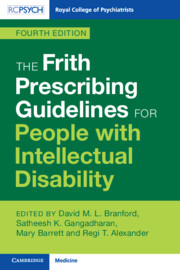Book contents
- The Frith Prescribing Guidelines for People with Intellectual Disability
- Reviews
- The Frith Prescribing Guidelines for People with Intellectual Disability
- Copyright page
- Contents
- Contributors
- Foreword
- Preface
- Acknowledgements
- Chapter 1 Intellectual Disability
- Chapter 2 Prescribing Practice
- Chapter 3 Physical Health Monitoring
- Chapter 4 Mental Health Conditions in People with Intellectual Disability
- Chapter 5 Trauma in People with Intellectual Disability
- Chapter 6 Anxiety Disorders
- Chapter 7 Depression
- Chapter 8 Bipolar Disorders
- Chapter 9 Schizophrenia
- Chapter 10 Aggression and Self-Injurious Behaviour
- Chapter 11 Personality Disorders
- Chapter 12 Sexual Offences and Paraphilias
- Chapter 13 Substance Use Disorders
- Chapter 14 Attention Deficit Hyperactivity Disorder
- Chapter 15 Autism
- Chapter 16 Sleep Disorders
- Chapter 17 Epilepsy
- Chapter 18 Dementia
- Chapter 19 Eating and Drinking Difficulties
- Chapter 20 Children and Adolescents
- Chapter 21 Prescribing for Health Issues in Women with Intellectual Disability
- Chapter 22 Older People
- Index
- References
Chapter 10 - Aggression and Self-Injurious Behaviour
Published online by Cambridge University Press: 07 November 2024
- The Frith Prescribing Guidelines for People with Intellectual Disability
- Reviews
- The Frith Prescribing Guidelines for People with Intellectual Disability
- Copyright page
- Contents
- Contributors
- Foreword
- Preface
- Acknowledgements
- Chapter 1 Intellectual Disability
- Chapter 2 Prescribing Practice
- Chapter 3 Physical Health Monitoring
- Chapter 4 Mental Health Conditions in People with Intellectual Disability
- Chapter 5 Trauma in People with Intellectual Disability
- Chapter 6 Anxiety Disorders
- Chapter 7 Depression
- Chapter 8 Bipolar Disorders
- Chapter 9 Schizophrenia
- Chapter 10 Aggression and Self-Injurious Behaviour
- Chapter 11 Personality Disorders
- Chapter 12 Sexual Offences and Paraphilias
- Chapter 13 Substance Use Disorders
- Chapter 14 Attention Deficit Hyperactivity Disorder
- Chapter 15 Autism
- Chapter 16 Sleep Disorders
- Chapter 17 Epilepsy
- Chapter 18 Dementia
- Chapter 19 Eating and Drinking Difficulties
- Chapter 20 Children and Adolescents
- Chapter 21 Prescribing for Health Issues in Women with Intellectual Disability
- Chapter 22 Older People
- Index
- References
Summary
Aggression is often defined with reference to the intended consequences of an act exhibited by a person, or as any behaviour exhibited by a person where they intentionally acted to cause harm to another. Behaviours which cause harm but without associated intent tend not to be defined as aggression. Some people with intellectual disability may engage in behaviours with intent to cause harm to another, while for others, especially those with severe to profound intellectual disability, an absence of intent may exist. Aggressive behaviour exhibited by people with intellectual disability can take the form of verbal threats, physical aggression directed towards others including punching, kicking, slapping and biting, amongst other behaviours, as well as property damage and destruction. Aggressive behaviour can cause serious harm to others which may be life-threatening and result in social exclusion and a reduced quality of life. This chapter provides an overview of severe aggression and self-injurious behaviour relevant to people with disorders of intellectual development, and focuses on the evidence base for the various challenging behaviours and whether there is benefit from medication or alternative approaches.
Keywords
- Type
- Chapter
- Information
- Publisher: Cambridge University PressPrint publication year: 2024

